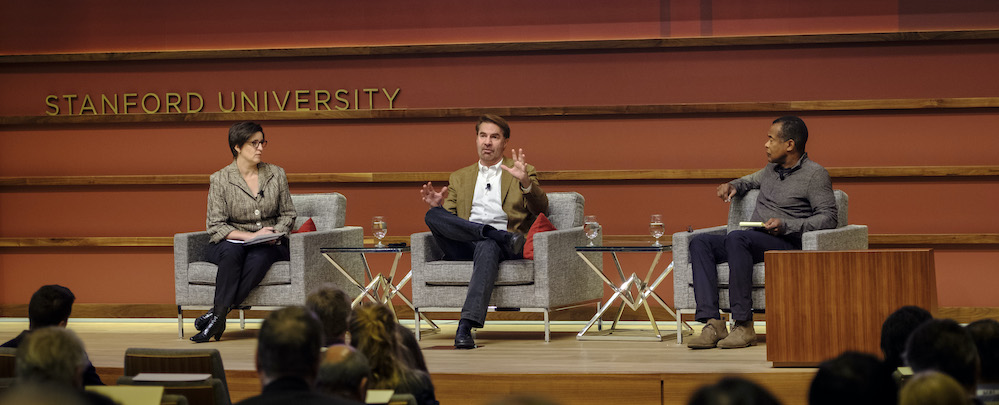3-minute read
How will work be changed by AI?
That’s the focus of the Stanford Institute for Human-Centered Artificial Intelligence (HAI) Conference and launch event for its new Digital Economy Lab. “Our focus is on how technology – specifically AI and digital technologies – is changing society and the economy,” says Digital Economy Lab executive director Christie Ko, who will serve as event MC. She helps run the lab with director Erik Brynjolfsson, a senior fellow at HAI and at the Stanford Institute for Economic Policy Research (SIEPR), who will play a central role as host and moderator during the virtual conference.
The October 27 launch features a range of visionary researchers, executives, and policy experts from the public and private sectors, including LinkedIn cofounder Reid Hoffman, Rhode Island Governor Gina Raimondo, and Stanford University President Marc Tessier-Lavigne.
Here, Ko answers questions about the launch event and the Stanford Digital Economy Lab’s broader mission. (Register for the free event and see the agenda here.)
Erik Brynjolfsson founded the lab with a mission to better understand the effects of digital technologies, both intended and unintended. If we succeed, our research can help create an economy that truly works for everyone. Our team is working to provide data and insights that will help shape the future of work.
As machine learning and AI systems are deployed, businesses and work are being fundamentally transformed. As part of Stanford HAI, much of our research is focused on understanding how jobs and tasks can be augmented by machine learning. Equally important is providing data and tools that help us work toward designing the AI-augmented jobs of the future. As technology becomes increasingly capable, we believe it is critical to make sure it serves humanity and reflects our values.
We see this as a critical time. We’re in the early days of a massive, AI-driven transformation. At this event, we’re bringing some of the biggest thought leaders together to talk about what’s happening for jobs and the economy today and in the future.
This event will highlight the latest thinking from the world’s experts, showcase timely discussions amongst academics, policymakers, and industry experts, and summarize some of the key research that we’re doing at Stanford. We’ve convened an outstanding group of speakers with diverse opinions, experiences, and points of view.
All who are interested in learning more about how AI is transforming work. Managers, workers, academics, programmers, educators, policymakers, students, CEOs – you name it!

Executive Director, Stanford Digital Economy Lab
It’s hard to pick just one – the whole event is packed with superstars. Our policy panel includes Condoleezza Rice, Mary Kay Henry, Mark Duggan, and Susan Athey, and is moderated by Gillian Tett. That’s an amazing group of people to talk about the policy implications of AI and the future of work. For example, Susan Athey has done groundbreaking work on demographics, labor, and AI adoption. And Mary Kay Henry, who’s president of the Service Employees International Union, will be able to share actual examples of AI being brought into different jobs, especially service jobs. We know there’s a lot already happening – it’ll be great to hear from someone closer to the front line. Add Mark Duggan and Condoleezza Rice to that, with Gillian Tett to keep the group focused on the hard-hitting questions the public wants answers to – you don’t always get that from policy panel discussions. This combination is really unique.
I’m sure some will attend to hear specific speakers like Reid Hoffman or Eric Schmidt. Or to learn about how our research team is building tools to help track and understand the transformation of jobs. But regardless of the specific content people initially tune in for, I hope people come away with the understanding that Stanford is not just creating the best AI technologies; we view studying the impact of AI on human workers and the economy as vital.
That’s a big reason why the Stanford Digital Economy Lab is being launched. We want to help solve these challenges. There’s no guarantee that AI will automatically be a benefit to most workers. We have to take action now to determine what the future holds. It’s through these types of conversations that we’re going to find the best pathways forward – to gain perspective and make informed, good decisions.
February 24, 2020
Brynjolfsson comes to Stanford as a senior fellow at the Stanford Institute for Human-Centered Artificial Intelligence (HAI) and as the Ralph Landau Senior Fellow in Economic Growth at the Stanford Institute for Economic Policy Research (SIEPR). He will also serve as a professor, by courtesy, of economics, and a professor, by courtesy, of operations, information and technology, at Stanford Graduate School of Business.
With his new roles at Stanford, Brynjolfsson will continue his scholarship and leadership in deepening the understanding of technological advances along with their societal and economic effects. Leading the launch of a new research hub, the Digital Economy Lab, will be an integral part of that.
He will also continue teaching when he joins Stanford.

“The opportunity to lead the new Digital Economy Lab is a huge part of what attracted me to Stanford,” Brynjolfsson said. “Digital technologies, especially AI, are profoundly transforming our society and economy. My passion is to understand that transformation. It’s not only an intellectual challenge but also important so we can steer the changes in ways that help create shared prosperity and widespread benefits.
“Stanford, and Silicon Valley, are the epicenter of that technological revolution and being here will be an immense help to my research agenda,” he said. Brynjolfsson is no stranger to Stanford. He has taught classes as a visiting professor at the business school and has been a frequent featured guest speaker. His recent appearances included headlining an event co-hosted by SIEPR and HAI on “The AI Awakening and the Coming Productivity Boom,” and speaking at HAI’s fall conference on “AI Ethics, Policy and Governance.”
He’s also co-authored papers with several Stanford economists, including SIEPR affiliates Paul Milgrom, Timothy Bresnahan, Brad Larsen, and Nicholas Bloom.
Fei-Fei Li, who co-directs HAI with John Etchemendy, said Brynjolfsson’s contributions will “deepen our understanding of how technology impacts humans, society, and the economy.”
“John and I are very pleased to welcome Erik to the Stanford faculty,” Li said. “Erik’s groundbreaking work on the digital economy and the future of work make him uniquely valuable to the work of both HAI and SIEPR.”
Mark Duggan, the Trione Director of SIEPR, said Brynjolfsson’s work will be instrumental in addressing burgeoning policy questions.
Brynjolfsson is currently the director of the MIT Initiative on the Digital Economy and the Schussel Family Professor at the MIT Sloan School. His research examines the effects of information technologies on business strategy, productivity and performance, digital commerce, and intangible assets.
Brynjolfsson was among the first researchers to measure the productivity contributions of IT and the complementary role of organizational capital and other intangibles. His research also provided the first quantification of the value of online product variety — often known as the “long tail”— and developed pricing models for information goods.
Brynjolfsson is one of the most widely-cited researchers in information system and economics. His body of work, spanning three decades, has been recognized with several “best paper” awards and five patents.

Director
He is a much sought-after speaker around the globe, ranging from business forums and academic conferences to government presentations and TED talks. And he has authored nine books, including, with co-author Andrew McAfee, The New York Times best-seller “The Second Machine Age: Work, Progress and Prosperity in a Time of Brilliant Technologies,” “Race Against the Machine,” and “Machine, Platform, Crowd: Harnessing Our Digital Future.”
At MIT, where he received a PhD in managerial economics, Brynjolfsson has taught popular courses on the Economics of Information and the Analytics Lab. Brynjolfsson has also taught at Harvard, where he holds bachelor’s and master’s degrees in applied mathematics and decision sciences. He has supervised more than 60 graduate students through their thesis work.
Brynjolfsson is also a research associate at the National Bureau of Economic Research, and co-founded the Inclusive Innovation Challenge which recognizes individuals and organizations for using technology to benefit everyone. He has served on the editorial boards of numerous academic journals.
Director
Digital Fellow
Robots can’t catch the COVID virus or get sick, and they can keep people at safe distances on factory or warehouse floors.
But Stanford researchers who have been interviewing and observing both robot manufacturers and major customers say that the pandemic hasn’t prompted a rush of robot purchases. Instead, they say, COVID is accelerating the demand for “plug-and-play” automation that is smaller, simpler, and easier to move from one job to another.
The researchers are studying how the COVID pandemic has affected robot deployment at companies in warehousing and logistics as part of a broader, multiyear research program of AI-powered robot adoption in the workplace. Erik Brynjolfsson, director of the Digital Economy Lab at Stanford’s Institute for Human-Centered Artificial Intelligence, initiated the program with Matt Beane, a digital fellow in Brynjolfsson’s lab and faculty member at UC Santa Barbara.
These companies, at the heart of fulfilling online purchases, already use a great deal of automation and have been racing to keep up with demand since the pandemic began.
In general, employees at all levels at those companies told the researchers they haven’t been adding big new robots. Why? Because larger-scale robotic systems are immobile and enormously difficult to incorporate into ongoing operations without significant disruption.
Many of the traditional warehouse automation systems are massive and often caged to keep them from hurting human workers. Such systems have to be integrated into a company’s information networks. And companies that install them usually have to reorganize their workflow processes, their workforces, and sometimes even their product lines.

Director
It was Robert Solow of MIT who first wrote about the productivity J-curve and who observed in the 1980s that advances in computing hadn’t had any apparent impact on overall productivity for many years. The reason for that “productivity paradox,” Solow argued, was that companies hadn’t figured out how to fully take advantage of that new computing power.
Brynjolfsson says robotics are at a similar point right now.
Because companies can’t re-engineer themselves on the fly, especially if they’re racing to keep up with current demand, adding major new robotic systems would clearly put companies on the down slope of the J-curve.
But Brynjolfsson and Beane argue in a new article that COVID may be accelerating a profound change that gets robotics to the upside of that J-curve.
“Plug-and-play” systems are much more mundane than the advanced robots that dominate the headlines. Most don’t even rely on artificial intelligence. But they embody sophisticated new automation that can be put to practical use with relatively modest preparation and disruption.
Plug-and-play systems include automated guided vehicles, which use laser-based LIDAR sensors to navigate around factory or warehouse floors. They also include computer-controlled conveyors and sorting machines and even automated baggers.
Automated baggers, for example, use sensors to analyze the size and shape of countless different products and then put each one into the proper-sized plastic bag for shipment to customers.
Brynjolfsson and Beane say the surging demand for plug-and-play systems signals a potentially profound shift toward robots that are highly sophisticated on the inside but appear simple on the outside. As robot manufacturers catch on to the rising demand for plug-and-play robots, spurred in part by the COVID pandemic, they will come closer to delivering the real promise of robot productivity.
May 10, 2021
November 09-10, 2021
Can basic income address the future of automated work? Should a public agency certify algorithms? How would we regulate AI-based decisions on platforms? Should there be ownership rights in data that fuel algorithms?
With artificial intelligence rapidly transforming every aspect of our world, calls for regulation, governance, and oversight are on the rise. During the HAI 2021 Fall Conference, we will consider four radical proposals for governing AI. Each substantive session will feature the short presentation of one radical proposal with discussion by a panel of experts from multiple disciplines and backgrounds.
The Stanford Institute for Human-Centered Artificial Intelligence invites you to propose a radical policy idea. Our panel of experts will review the submissions and choose proposals to discuss live at the conference. Policy ideas should be focused on the impact of artificial intelligence on humanity.
We welcome policy proposals from anyone, living anywhere, aimed at any geography or level of government. This event is not limited to the United States.
Deadline for proposals: May 10, 2021. Selections will be announced by June 30, 2021
Eligibility: Open to the public. Limit one submission per person.
July 17, 2020
July 17, 2020
Some products become a lot more valuable when you are forced to sit at home all day due to a pandemic. A serendipitous study of consumers in the UK tells us exactly which ones.
July 18, 2020
June 18, 2020
Understanding how a country’s mix of occupations, technology infrastructure, and demographic characteristics have affected people’s ability to work from home can help government and business leaders prepare for future disruptions.
S-DEL Seminar Series | March 9, 2021
Director
Today, however, we have increasing inequality, not economic convergence. Technological advances are putting quality jobs out of reach for workers who lack the proper skills and training.
MIT’s William Bonvillian and Sanjay Sarma recently joined Stanford Digital Economy Lab Director Erik Brynjolfsson to discuss their book, Workplace Education: A New Roadmap. The new release offers a roadmap for rebuilding America’s working class and argues that we need to train more workers more quickly with innovative methods of workforce education being developed across the country.
S-DEL News | March 22, 2021
Director
47 mins
Stanford Digital Economy Lab Director Erik Brynjolfsson joins the Sprint to Success with Design Thinking podcast to discuss reinventing industries and shaping our destiny in an era of rapid digital transformation. Erik shares his optimistic view of the relationship between humans and machines, and talks about the need to reinvent education.
December 1, 2019
Director
Digital Fellow
November-December 2019 issue
Macroeconomic indicators can be precisely measured, but they tell only part of the story. Well-being metrics convey a truer picture of how consumers are doing, but they are more subjective. By considering an array of measures, including our GDP-B metric, policy makers, regulators, and investors can establish a better foundation for decision making.